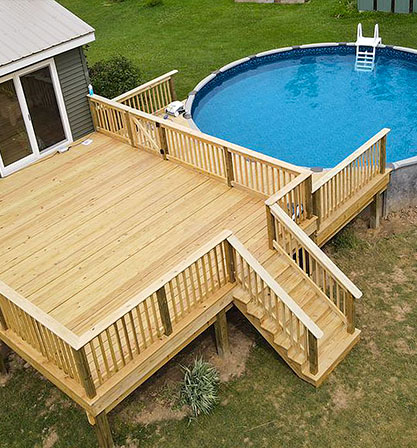Get a quote today from a local expert specializing in deck installation Austin TX.
Get a quote today from a local expert specializing in deck installation Austin TX.
Blog Article
Exactly how to Pick the Right Materials for Your Deck Installation Project
Selecting the appropriate materials for your deck setup project can appear difficult. There are countless factors to think about, from longevity and maintenance to aesthetics and ecological effect. The selection in between traditional timber and composite products, each with its own set of advantages and disadvantages, can be specifically difficult. The trick is to stabilize your budget, design preferences, and lifestyle needs to develop a deck that will enhance your exterior room for years to find.
Recognizing the Various Kinds Of Deck Materials
When starting a deck installation project, the option of materials comes to be a crucial choice. Different alternatives are available, each with distinct features and visual charm. Traditional timber, for circumstances, uses an ageless, all-natural appearance and is commonly much more economical. Nevertheless, it can warp over time and calls for normal maintenance. Composite materials, on the various other hand, are a blend of timber and plastic, offering sturdiness and resistance to weather aspects. They require much less upkeep contrasted to timber however are normally more costly. Another alternative is plastic, which is virtually maintenance-free and immune to insects and rot, albeit much less natural-looking. By comprehending these distinctions, homeowners can make an extra informed choice on one of the most appropriate deck material for their certain needs.
Evaluating the Longevity and Upkeep Demands of Deck Products
Assessing the resilience and upkeep needs of deck materials is a crucial action in deck installment. Toughness includes the material's ability to stand up to rough weather, wear and tear, and its durability. For example, cedar and redwood are normally immune to rot and bugs, making them long lasting options. On the other hand, pressure-treated timber, while sturdy, may call for even more maintenance because of its susceptibility to fracturing and warping.
Comprehending maintenance demands is just as crucial. Some products require normal securing or discoloring to keep their look and withstand dampness damages, while others, like composite decking, require much less upkeep. By examining these variables, one can pick the most ideal decking product, ensuring a balance between longevity, maintenance needs, and visual allure.
Expense Analysis: Contrasting Timber and Compound Decking
Although cost might originally seem like an additional problem, it is a significant aspect when comparing wood and composite outdoor decking. On the various other hand, composite decking, while costlier initially, requires less upkeep, potentially lowering long-lasting expenses. Prospective deck proprietors need to consider their budget plan and desire to keep their decks when determining in between wood and composite decking.
Appearances and Style Adaptability of Decking Products
Natural wood decking offers a timeless, ageless look, while composite products use a large variety of colors and textures to match diverse tastes and styles. Compound materials, while less versatile in layout, are still versatile enough for many deck layouts. These aspects, consequently, are crucial components in the selection of decking material.
Environmental Influence of Decking Materials
When selecting decking products, one need to consider not only aesthetics and resilience, but additionally the ecological impact. It is essential to assess the sustainability of materials and discover recycled decking options. Additionally, comprehending the possible effect on neighborhood communities will ensure a much more ecologically responsible selection.
Analyzing Product Sustainability
In the world of deck construction, examining material sustainability is an important action. Composite outdoor decking materials commonly integrate wood and plastic, decreasing the need for brand-new timber yet increasing dependence on fossil fuels - deck installer austin. Thus, the choice of outdoor decking materials should balance check here capability, looks, expense, and sustainability to make certain an accountable and durable installment.
Recycled Outdoor Decking Alternatives

Composite decking is specifically popular due to its sturdiness and simplicity of upkeep. It's resistant to rot, bugs, and fading, making it a long-lasting option. Recycled plastic decking, on the various other hand, is extremely resistant and calls for minimal maintenance. While these materials may carry a higher first price, their longevity and reduced ecological influence make them a smart financial investment for the eco-conscious homeowner.

Influence On Local Ecological Communities
While the advantages of making use of recycled products for outdoor decking can not be overstated, it's equally important to take into consideration the more comprehensive environmental ramifications of these selections. Correct disposal of old decking is important to minimizing landfill waste. Essentially, an eco-conscious deck job demands cautious product choice, lasting sourcing, and accountable disposal.
Making Your Decision: Tips for Choosing the most effective Deck Products
As the article shifts right into the subtopic of "Making Your Decision: Tips for Choosing the very best Deck Products", it is essential to recognize the range of deck materials available. Striking an equilibrium in between resilience and looks is crucial in this option process. The complying with conversation will certainly assist viewers in making an informed selection based upon these vital considerations.
Understanding Different Deck Products
The task of choosing the ideal products for your deck installment can appear intimidating because of the substantial range of alternatives readily available. However, understanding the different products can streamline this procedure. Wood is a preferred option, supplying a timeless visual and cost. Kinds of timber used consist of pressure-treated lumber, cedar, and redwood. Compound materials, made from a blend of wood and plastic, are low-maintenance and resistant to rot and pests. Vinyl or PVC decks are even extra sturdy and need much less maintenance than composite materials, yet they can look less all-natural. Light weight aluminum decks are strong, light-weight, and resistant to rot, however they are additionally the most costly option. Each product has its own advantages and drawbacks, making it essential to consider your specific demands prior to making a final decision.
Toughness vs. Visual Appeals Balance
Balancing resilience with aesthetics can be a challenge when choosing deck materials. The choice commonly steams down to individual preferences and the deck's planned use. High-traffic areas may demand durable products like composite outdoor decking, which withstands deterioration however might deck installation austin tx lack the all-natural elegance of wood. On the other hand, timber offers a timeless charm and heat that synthetic materials battle to reproduce. It needs more maintenance and may not last as long. Therefore, homeowners require to strike a important source balance, thinking about both the deck's sensible needs and their visual preferences. By doing so, they can ensure their deck continues to be a useful and appealing outdoor room for several years ahead.
Conclusion
In conclusion, selecting the best products for your deck setup task needs mindful consideration of factors such as durability, upkeep, cost, visual appeals, and ecological effect. Whether you choose for conventional timber or composite materials, your choice should straighten with your spending plan, design choices, and way of living. Ultimately, the most effective decking product is one that boosts your outside area and gives enjoyment for many years ahead.
Report this page